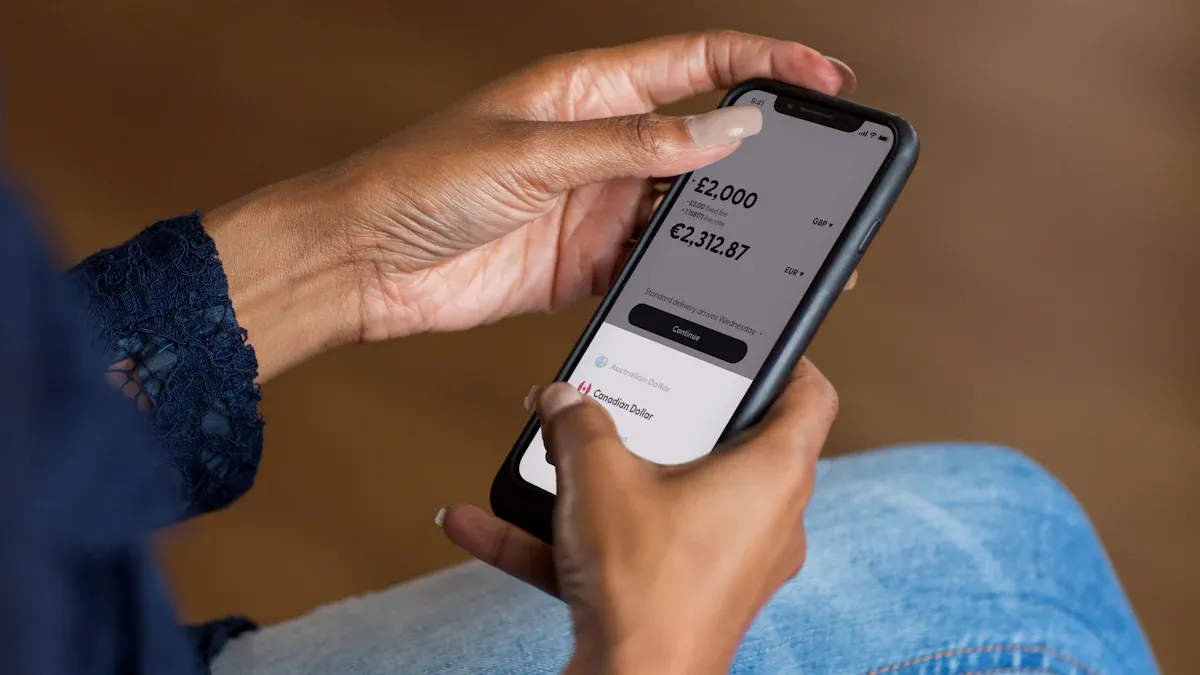- EasyCard
- Trade
- Help
- Announcement
- Academy
- SWIFT Code
- Iban Number
- Referral
- Customer Service
- Blog
- Creator
Understanding the Transfer Limits and Influencing Factors When Transferring Money from the UK to the US

Image Source: unsplash
There is no uniform fixed limit for transferring money from the UK to the US. The actual transfer limit is primarily determined by the transfer service provider, the individual account status, and relevant regulations. These factors work together to determine the specific amount that can be remitted in a single transaction or within a specific period.
Many people are concerned about what their daily transfer limit is. They also want to know how to increase their transfer limit through simple steps to meet the needs of larger fund transfers.
Key Points
- There is no fixed limit for transferring money from the UK to the US; limits are determined by the transfer service provider, account status, and regulations.
- Banks, online remittance services, and third-party payment platforms have different transfer limits, with online services typically offering higher limits.
- Account verification level, transfer history, and source of funds affect transfer limits.
- For single or daily transfers exceeding $10,000, financial institutions will report to the US government.
- Completing advanced identity verification and communicating large transfers in advance can help increase limits.
Transfer Limits Across Different Channels

Image Source: pexels
Choosing different transfer channels, users will encounter vastly different limit regulations. Traditional banks, online remittance services, and third-party payment platforms have distinct limit policies when handling fund transfers from the UK to the US. Understanding these differences is the first step in making an informed choice.
Limits of Traditional Banks
Conducting international wire transfers through traditional banks is the preferred choice for many people handling large fund transfers. Banks typically offer higher per-transaction limits, but these limits are not without caps and are influenced by account type and customer relationship.
For example, major UK banks set different daily online transfer limits for their customers. These restrictions aim to balance convenience and security.
| Bank | Daily Online Transfer Limit (GBP) |
|---|---|
| Barclays (Personal Customers) | Up to £50,000 to existing payees |
| HSBC | Up to £25,000 via online banking |
| Lloyds | Up to £25,000 per day |
Tip: Banks’ limit systems are relatively complex. For instance, some banks set lower initial limits for newly added payees or transactions initiated via mobile banking.
Additionally, account tier directly affects limits:
- Ordinary personal accounts may have a daily limit of around £50,000.
- Higher-tier Premier accounts or business accounts may have daily limits increased to £100,000 or more.
It should be noted that banks’ daily limits typically cover all types of payments, including instant transfers, bill payments, and international payments set up on the same day. If customers need to transfer funds exceeding the online limit, they usually need to visit a bank branch in person and may need to provide additional documents.
Limits of Online Remittance Services
In recent years, online remittance services (Online Remittance Services) have gained popularity due to their convenience and cost-effectiveness. The transfer limits of these service providers are usually directly linked to the account verification level. A fully verified account can obtain extremely high transfer limits.
Compared to banks, many professional remittance service providers offer greater flexibility for large transactions. The chart below visually compares the maximum limits of several mainstream providers for fully verified accounts.
From the chart, it can be seen that:
- Wise: Provides up to $1,000,000 per transaction for fully verified accounts and allows multiple transactions.
- Revolut: Generally has no limit for transfers from the UK to the US, showing great flexibility.
- Western Union: After verification, users can send up to $50,000.
These service providers usually set limits for different cycles, such as 24 hours, 30 days, or 180 days. Users can clearly view their current limits on the settings page of their accounts.
Limits of Third-Party Payment Platforms
Third-party payment platforms like PayPal, while also supporting international transfers, are primarily designed for small commodity transactions and person-to-person payments. Therefore, their limits are generally lower than those of professional remittance services and banks.
For transfers from the UK to the US:
- A verified PayPal account can send up to $60,000.
- However, the amount per transaction may be limited to within $10,000.
This means that if a user needs to transfer, for example, $30,000, they may need to split it into at least three separate transactions. This method is not only cumbersome but may also incur additional fees due to multiple transactions. Therefore, for users with large fund transfer needs, third-party payment platforms may not be the most efficient or economical choice.
Key Factors Affecting Transfer Limits

Image Source: pexels
The user’s transfer limit is not fixed. It is influenced by multiple dynamic factors, and understanding these factors helps users manage large fund transfers more effectively.
Account Verification Level
The transfer limit set by the service provider is closely related to the user’s account verification level. An account that only provides basic information usually has a lower limit, while completing advanced verification can unlock higher limits.
| Verification Type | Required Documents |
|---|---|
| Basic Verification | Full legal name, date of birth, current address details |
| Advanced Verification | Valid identity document (such as passport), facial recognition via selfie |
Completing advanced verification proves the user’s identity to the service provider, thereby reducing risk and making them willing to approve larger transactions.
Transfer History and Frequency
When evaluating a user’s request, remittance service providers refer to their past transaction history. An account with a good record, such as completing multiple compliant transfers on time, is more likely to gain the provider’s trust. Consistent and stable transaction behavior helps gradually increase potential transfer limits. Conversely, irregular or flagged suspicious transactions may lead to limit restrictions.
Source and Purpose of Funds
For large transfers, financial institutions must understand the source and purpose of the funds to comply with anti-money laundering (AML) regulations. Users need to prepare proof documents to explain where the money comes from.
Common proofs of source of funds include:
- Property Sale: Final sales contract, lawyer’s letter.
- Salary Income: Recent payslips, employment contract.
- Investment Income: Investment proof, broker statements.
- Inheritance: Will, probate certificate.
Additionally, certain transfer purposes may face stricter scrutiny. For example, “all-cash” property transactions in the US may attract special attention from institutions, as such transactions are sometimes used to evade financial institution oversight.
US Reporting Requirements
When the total amount of a single or associated daily transactions exceeds $10,000, it triggers mandatory US reporting requirements. This is to combat financial crime and money laundering.
Important Note: This reporting obligation is usually fulfilled by the financial institution handling the remittance (such as a bank or Wise). They will submit a “Currency Transaction Report (CTR)” to the US Treasury’s Financial Crimes Enforcement Network (FinCEN).
Although the reporting is completed by the institution, individual users are responsible for understanding this regulation and providing all necessary information to ensure transfer compliance. Deliberately splitting large transactions to evade the reporting threshold (known as “structuring”) is illegal and may result in frozen transactions or closed accounts.
Comparison of Limits for Mainstream Service Providers
When choosing a remittance service, comparing the limit systems of different providers is crucial. Wise, Revolut, and traditional bank wire transfers each have distinct characteristics in limits, fees, and flexibility, suitable for users with different needs.
Wise: Flexible Limit System
Wise’s limit system is renowned for its flexibility. The user’s transfer limit mainly depends on the account verification level. A user who only provides basic information will face lower limits, while an account verified with identity and address can unlock up to $1,000,000 per transaction.
Wise usually sets limits for different cycles, such as:
- 24-hour limit: Controls the total transfer amount in one day.
- 30-day limit: Manages the cumulative transfer amount in one month.
- 180-day limit: Controls the total for longer periods.
Users can clearly view these dynamically changing limits on the “Limits” page of their personal accounts, thereby better planning fund transfers.
Revolut: Limits Based on Membership Tier
Revolut’s limit strategy is closely tied to its membership tiers. Although it does not set a hard limit on international transfers from the UK to the US, its currency exchange policy directly affects the final cost of large transfers. Revolut sets a 30-day rolling fair usage limit, with additional fees for amounts exceeding it.
Revolut’s membership plans directly determine the user’s free exchange limit:
- Standard: Exceeding $1,000 per month incurs a 0.5% fee on the excess.
- Premium: Exceeding $10,000 per month incurs a 0.5% fee on the excess.
- Metal: No additional exchange fees, suitable for users frequently conducting large transactions.
Additionally, users can perform up to 100 currency exchanges within 24 hours. This dynamic system based on membership tiers allows users to choose the most suitable plan based on their transfer frequency and amount.
Bank Wire Transfer: Higher Per-Transaction Limits
For users needing to handle large funds, bank wire transfers are a traditional and reliable choice. Banks typically offer higher per-transaction limits than online services. For example, the daily online international transfer limits of major UK banks are usually between $31,250 and $62,500.
However, high limits come with stricter review processes and higher costs.
Note: If the transfer amount exceeds the online limit, users usually need to visit a bank branch in person. In such cases, the bank will require detailed proof of source of funds and conduct stricter due diligence. For instance, a large licensed bank may require customers to provide complete transaction background documents to ensure compliance when handling transactions over $100,000.
Wire transfers are fast, but the fees are relatively high. The table below compares the main differences between wire transfers and other transfer methods:
| Feature | Wire Transfer | Electronic Funds Transfer (EFT) |
|---|---|---|
| International Transfer Fee | Approximately $30 - $80 | Lower, but banks may charge high fees |
| Processing Time | Usually same day or next day | 1-3 business days |
| Typical Use | Large transactions, urgent payments, international payments | Small, recurring payments |
This table clearly shows that although wire transfers are more expensive, they have clear advantages in handling high-value or time-sensitive international transactions and are the preferred choice for many businesses and individuals handling large assets (such as property).
How to Increase Transfer Limits
Users can effectively increase their remittance limits through some proactive steps. Understanding and following the service provider’s regulations can make the process of transferring large funds smoother.
Complete Advanced Identity Verification
The most direct way to increase limits is to complete advanced identity verification for the account. Service providers need to confirm the user’s real identity to reduce risk. This usually requires users to submit clear identity and address proof documents.
Tip: An account that only provides basic information usually has a lower limit. Submitting more proof documents can prove the user’s credibility to the service provider, thereby unlocking higher limits.
Common acceptable documents include:
| Document Type | Example |
|---|---|
| Identity Proof | Unexpired passport, driver’s license, or national ID card. |
| Address Proof | Utility bill, bank statement, or local government tax bill from the past three months. |
Communicate Large Transfers in Advance
If a user plans to make a transfer far exceeding the usual amount, communicating with the bank or remittance service provider in advance is a wise choice. Users can contact the customer service team to inform them of the expected transfer amount and time. This proactive communication helps the service provider prepare in advance, avoiding transactions being automatically flagged or delayed by the system. At the same time, users can also learn in advance what additional documents need to be prepared.
Prepare Proof of Source of Funds
For large transactions, financial institutions have a legal obligation to understand the legitimate source of funds. Therefore, users need to prepare relevant documents to prove that the source of funds is legitimate.
Depending on the source of funds, users can prepare the following documents:
- Salary Accumulation: Recent payslips or employment verification letter issued by the employer.
- Property Sale: Final sales contract for the property and bank statement showing the funds credited.
- Inheritance: Will or trust fund and other related legal documents.
Users should ensure that all documents are up-to-date and clearly readable, and attach certified English translations (if the original documents are not in English).
Plan Batched Transfers
If a single amount exceeds the transfer limit set by the service provider, users can consider splitting the total amount into several smaller transfers, completed in batches over a few days. This method can help users complete fund transfers without violating the provider’s daily or per-transaction limits.
Important: Users should note that this method is only applicable to addressing limits set by the service provider. Users should not deliberately split transactions to evade the legal reporting threshold of over $10,000, as this behavior is illegal.
The limit for transferring money from the UK to the US is not fixed. It is jointly determined by the service provider’s policy and the user’s account status. Transactions exceeding $10,000 will trigger US reporting requirements. Users should choose the most suitable service based on transfer amount, frequency, and timeliness.
Final Recommendation: Before initiating a large transfer, users must log in to their account to check personal limits and prepare proof of source of funds and other documents in advance to ensure a smooth process.
FAQ
Is there a legally mandated maximum limit for transfers from the UK to the US?
Neither UK nor US law sets a specific maximum limit per transfer. Limits are mainly determined by the bank or remittance service provider chosen by the user based on their risk policies. Users need to check the specific provider’s regulations to understand their personal limits.
What happens if a transfer exceeds $10,000?
When a transaction exceeds $10,000, the financial institution must report to the US government agency (FinCEN). This is to prevent financial crime. Reporting is usually completed automatically by the institution, and users only need to ensure that the information provided is true and accurate.
How can I quickly increase my transfer limit?
The fastest way to increase the limit is to complete advanced identity verification. Users need to submit valid identity proof (such as a passport) and address proof (such as a utility bill) to the service provider. This proves the credibility of the user’s identity, thereby unlocking higher limits.
Can I split a large fund into multiple small transfers to avoid reporting?
No. Deliberately splitting large transactions to evade the $10,000 reporting threshold is illegal and is called “structuring.” Financial institutions’ systems can detect such behavior, which may lead to account freezing or closure.
Through this in-depth breakdown of UK-to-US transfer limits, we’ve illuminated their dynamic caps (banks £25,000-£50,000 daily vs. Wise $1,000,000 per transfer) for flexibility, effectively tackling fixed ceilings, verification delays, and AML document hassles—ideal for cross-border family support or business settlements. Yet, for demands broadening to global multi-currency swaps, digital asset links, or elevated volumes, a fuller, low-fee platform delivers seamless refinement, bypassing banks’ £50,000 daily caps and PayPal’s $60,000 overall limit. BiyaPay, the premier cross-border payment expert, enables instant conversions between over 30 fiat currencies and 200+ cryptocurrencies, with real-time exchange rate queries securing optimal mid-market rates like the current GBP/USD around 1.30, free of hidden surcharges.
Simply register quickly to access remittance fees as low as 0.5%, spanning most countries worldwide with same-day arrivals. This outpaces Revolut’s tiered rates (0.5%-1%) and Western Union’s $50,000 cap, fortified by multi-layer encryption, multi-factor authentication, and live tracking for worry-free large-sum security. Whether handling ABA/SWIFT code verifications or $10,000+ FinCEN filings, BiyaPay’s worldwide web mitigates splitting risks and maximizes fund value.
Don’t let caps constrain your flow! Visit the real-time exchange rate query now to track live GBP/USD trends and launch your free account. Choose BiyaPay and embrace an unlimited, secure UK-US transfer era where every fund move is efficient and free.
*This article is provided for general information purposes and does not constitute legal, tax or other professional advice from BiyaPay or its subsidiaries and its affiliates, and it is not intended as a substitute for obtaining advice from a financial advisor or any other professional.
We make no representations, warranties or warranties, express or implied, as to the accuracy, completeness or timeliness of the contents of this publication.




Contact Us
Company and Team
BiyaPay Products
Customer Services
is a broker-dealer registered with the U.S. Securities and Exchange Commission (SEC) (No.: 802-127417), member of the Financial Industry Regulatory Authority (FINRA) (CRD: 325027), member of the Securities Investor Protection Corporation (SIPC), and regulated by FINRA and SEC.
registered with the US Financial Crimes Enforcement Network (FinCEN), as a Money Services Business (MSB), registration number: 31000218637349, and regulated by FinCEN.
registered as Financial Service Provider (FSP number: FSP1007221) in New Zealand, and is a member of the Financial Dispute Resolution Scheme, a New Zealand independent dispute resolution service provider.



















